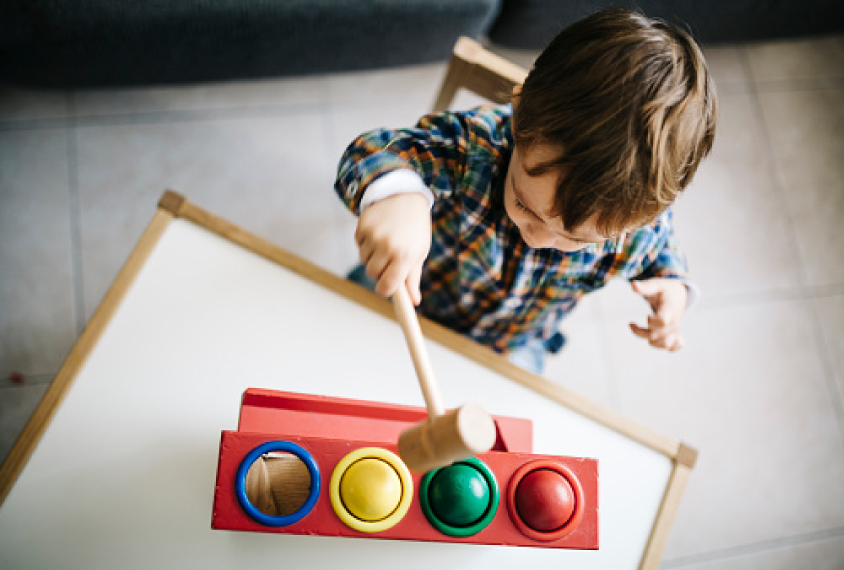
Siblings of children with autism may show early setbacks
About 1 in 10 toddlers who have an older sibling with autism have cognitive and motor delays.
About 1 in 10 toddlers who have an older sibling with autism shows delays in cognitive and motor development, according to the largest-yet study of these so-called ‘baby sibs’1.
As many as one in five baby sibs are eventually diagnosed with autism. About one in three end up with psychiatric diagnoses such as attention deficit hyperactivity disorder (ADHD).
Early cognitive and motor delays may serve as warning signs for these later difficulties, says lead investigator Tony Charman, chair of clinical child psychology at King’s College London. The study appeared 15 July in Autism Research.
“It may be that some of these children go on to have a more frank autistic presentation,” Charman says. “Or it might be that some of these children [are] vulnerable to having increased rates of things like anxiety difficulties and ADHD symptoms as they grow older.”
Understanding how early delays track with later diagnoses may provide clues to why some baby sibs fare better than others, says Joseph Piven, Thomas E. Castelloe Distinguished Professor of Psychiatry at the University of North Carolina at Chapel Hill.
“What factors might promote resilience later in life, and what factors might contribute to a poorer outcome?” asks Piven, who was not involved in the study.
Scoring skills:
Charman’s team analyzed data from the High Risk Baby Siblings Research Consortium, a network of researchers at 21 institutions. The data were from 859 baby sibs and 473 controls, all aged 3 years.
The researchers relied on results from a standardized assessment of gross motor skills, such as standing and walking, as well as fine motor skills, such as drawing and stacking blocks. The test also gauges language ability and cognition. The researchers assigned each child a score based on his or her performance across all the skills.
Nearly 11 percent of baby sibs had at least a mild developmental delay compared with about 3 percent of controls, the researchers found.
Charman and his team then looked at the language scores of children who did not meet the cutoff for overall delays. They did not find signs of language delay in these children.
This result contrasts with those from previous studies, which found slow language development in some younger siblings of children with autism. That may be because Charman’s team looked at the number of children who scored below a cutoff whereas the other studies averaged the score for all baby sibs versus all controls.
The latter approach is more sensitive for detecting differences between groups, says Thomas Frazier, director of research at the Cleveland Clinic Foundation, who was not involved in the study.
It’s also possible that the baby sibs with language difficulties fell into the overall developmental delay group. What’s more, the language test the team used doesn’t measure how well children use or understand language in a social context — which is what most children with autism have trouble doing.
Subtle signs:
Charman and his team looked at autism features in the children using two diagnostic tests: the Autism Diagnostic Observation Schedule and the Autism Diagnostic Interview-Revised. They found that baby sibs are more likely to have autism features than controls are, a finding consistent with decades of similar evidence.
Baby sibs are also likely to have relatively poor ‘adaptive functioning’ — the ability to communicate, interact, move and perform daily tasks.
Girls in both groups do better than boys on tests of cognitive and motor development and have fewer autism-like traits. This result supports the idea that girls are somehow protected against autism.
The researchers found that rates of developmental delay and daily living difficulties are lower among children of women with a college education than among children of women who do not have a college education. Most of the women in the study were highly educated, so the study may underestimate the rate of delays in baby sibs.
Charman and his colleagues are continuing to follow the children to track how early developmental delays relate to future problems. In the meantime, clinicians should be on the lookout for delays and difficulties in baby sibs, Frazier says.
“These things are emerging early in life and could lead to untoward outcomes,” Frazier says. “So we may need to catch these kids and intervene.”
References:
- Charman T. et al. Autism Res. Epub ahead of print (2016) PubMed
Recommended reading

New organoid atlas unveils four neurodevelopmental signatures
Explore more from The Transmitter

The Transmitter’s most-read neuroscience book excerpts of 2025

Neuroscience’s leaders, legacies and rising stars of 2025


